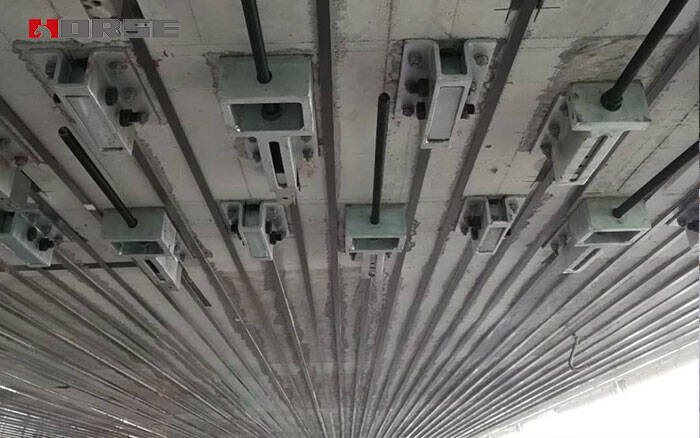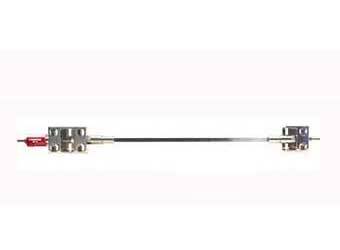Solutions
Horse Construction offers full range of structural strengthening materials with technical supports, documentation supports, products supports, project supports.
Application of Pre-stress Technology on Bridges


Advantages and principles of prestressed reinforcement technology
What is prestress?
Pre-stress is to artificially give the component a certain means to obtain pre-stress before it is put into use. The purpose of this is to allow the concrete components to work well under the external load. Try to prevent the concrete components from working with cracks, or delay the time of working with cracks, or make the cracks that have appeared no longer develop. The purpose of its work is to prevent the bridge structure from continuing to crack, and to improve the durability, rigidity and service life of the structure. It is also to prevent the bridge from developing new cracks.
In actual engineering, strengthening the bridge can improve the stiffness of the bridge, increase the use capacity of the bridge, and increase the resistance of all aspects of the bridge.
Advantages of prestressed reinforcement:
(1) Improve the resistance and rigidity of components or structures. After the component has the prestress, the ability of all aspects of the component is improved, and the probability of cracks is also reduced. If the component force is reasonable and the prestress technology is used correctly, the component may not even have cracks, thereby improving the rigidity and service life of the component;
(2) It can save materials, make full use of the role of materials, and reduce the weight of components;
(3) The structure is more safe and reliable. Because after the prestress is applied, the component is put into use again, then the steel and concrete have already undergone a strength and rigidity test at this time. If the applied prestress is reasonable, then this kind of component will not have major quality problems in general under circumstances;
(4) It can prevent the fatigue damage of the structure or components. Because the rigid concrete member obtains a strong prestress, the load variation range received during the use stage will be greatly reduced, so the fatigue resistance performance is good. These advantages of pre-stress technology can help us solve many problems, and it is reasonable to use pre-stress in bridge reinforcement.
Materials used for external prestress reinforcement
In the external prestressed reinforcement technology, the construction is more convenient, the bridge cracks are also obvious, and the instrument is easy to detect. Carbon fiber is a good material with light weight and low cost. Then carbon fiber is an ideal material that can be used in prestressing technology. Recently, everyone uses this technology, and there is a growing trend.
Compared with other bridge prestress reinforcement technologies, carbon fiber board has the following advantages:
(1) After rigorous testing, carbon fiber board has a strong ability to resist damage, even exceeding the strength of steel. And we all know that this kind of synthetic material has a small density, the same volume of carbon fiber board has a small weight and good flexibility, which is an ideal material in building materials;
(2) Carbon fiber board has strong corrosion resistance and is much stronger than steel. At present, carbon fiber board has the strongest corrosion resistance among building materials. In an exposed environment, pre-stressed steel bars or steel strands need to take certain protective measures, and regular maintenance or replacement;
(3) Good fatigue stress resistance and good relaxation performance. According to recent experimental data, after tens of thousands of fatigue stresses are applied, the ultimate strength of the carbon fiber board is basically not lost, or the loss is very small, and the relaxation loss is also very low. According to the advantages of the above carbon fiber board, it is feasible to replace the reinforcing steel (steel strand) with carbon fiber board in the external prestressed reinforcement.
Prestressed reinforcement method for externally anchored FRP tape
Fiber-reinforced composite materials (FiberReinforcedPolymer/Plastic, referred to as FRP) are made of materials with strong fibers and mixed with other fiber materials. This material also has many advantages that other materials do not have:
(1) High strength and large modulus;
(2) No electricity, very safe use, less recycling, not afraid of fatigue, light weight;
(3) It has good corrosion resistance and durability;
(4) It has good designability, which enables this material to be widely used;
(5) It has an expansion coefficient similar to that of concrete. This feature also enables FRP materials to play a pivotal role in pre-stressed reinforcement, which can meet the current bridge design and construction of large-span, light-weight, environmentally friendly, and beautiful.
You can find anything here you are in need of, have a trust trying on these products, you will find the big difference after that.

Prestressed carbon fiber reinforced polymer(CFRP) plate for slab, beam strengthening to increase stiffness, reduce distortion and deflection of members, reduce the cracks, avoid and stop cracking.

Prestressed carbon fiber reinforced polymer(CFRP) strip for slab, beam strengthening to increase stiffness, reduce distortion and deflection of members, reduce the cracks, avoid and stop cracking.

Prestressed carbon fiber reinforced polymer(CFRP) laminate for slab, beam strengthening to increase stiffness, reduce distortion and deflection of members, reduce the cracks, avoid and stop cracking.